Navigating New Waters
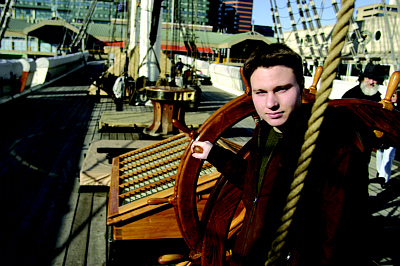
Trevor Adler, here on the
Constellation, combined his history and maritime interests
to research the raising of ships.
PHOTO BY HPS/WILL KIRK (except
where indicated)
|
PURA grants launch 41 undergraduates into a sea of research
projects
In its 11-year existence, the
Provost's
Undergraduate Research Awards program has given 483
students grants approaching $1 million to follow their
curiosity, thanks to funding primarily from the Hodson
Trust.
With Hodson support, the university is able to offer
its undergraduates two opportunities each year to apply for
stipends to conduct independent research during the summer
or fall. It's a commitment that the university feels is
central to its mission, said Steven Knapp, university
provost and senior vice president for academic affairs.
"Since its beginnings, Johns Hopkins has always
emphasized the value of learning through discovery, and
this program is an important opportunity for undergraduates
to work in this tradition with our best and most creative
faculty at the forefront of their fields," Knapp said.
Forty-one students from the schools of Arts and
Sciences, Engineering and Nursing and from Peabody will
present their work from 3 to 6 p.m. on Thursday, March 11,
in the Glass Pavilion at Homewood. The entire Hopkins
community is invited to the event, which begins with an
informal poster session allowing students to display and
talk about their projects. At 4:15 p.m., PURA recipient
Katherine McDonough and others will a perform a piece by
Jean Baptiste Leclerc, a writer/politician/composer during
the French Revolution and the focus of McDonough's
project.
An awards ceremony hosted by Knapp will begin at 4:30
p.m. and will be followed by a reception. As part of the
ceremony, guests will hear a preview of recipient Daniel
Davis' historically based opera, which will premiere at
Peabody.
By design, PURA grants are driven by students'
interests and cover a wide range of topics. The 2003
projects are no exception. A sampling follows.

Raising ships
In his PURA proposal, Trevor Adler put it this way:
"From maritime historians to oceanographers, from sailors
to sea-loving landlubbers, and from adults to children, the
subject of sunken ships, their discovery and their raising
are subjects that excite many a reader." And especially
Adler, a senior history major who grew
up on New York's
Long Island.
In a course on the Civil War taught by Michael
Johnson, Adler became interested in the several U.S. and
Confederate ships that were sunk and then raised, and he
became intrigued not only by the methods used but also by
the motivations behind raising them.
So last summer, Adler spent six weeks at the Munson
Institute of Mystic Seaport in Mystic, Conn., home to the
largest maritime library in the United States, with some
65,000 volumes and more than 700,000 manuscripts.
It was here that Adler found detailed correspondence
on the efforts to raise three ships, two English and one
Swedish. What Adler learned is that the motivations to
raise the ships didn't necessarily stem from financial
considerations.
The Mary Rose, an English warship named for King Henry
VIII's sister, was the king's favorite war vessel. It sank
during an engagement with the French in 1545, but not
because it was damaged in the battle. Essentially, the ship
was turned too quickly and heeled over, taking on water and
sinking, all within sight of land and the Portsmouth
Harbor, where King Henry himself watched.
"It was a ship that really meant something to the
king," said Adler. And that was the main reason crews tried
to raise it, which they did by attaching ropes to the
sunken ship from two other ships at low tide, in hopes of
floating it free. It didn't work. In fact, of the three
ships that Adler studied, all raising efforts failed. "It
was almost pathetic to try to raise ships of this size,
loaded with cannon, with pulleys and the tides," Adler
said. "But they tried."
Michael Johnson, whose class had piqued Adler's
interest in the subject of raising ships, said about his
work, "He's extremely thoughtful. He's creative and
imaginative, and he's extremely disciplined. I think his
research skills are superb."
Adler, whose sponsor was John Russell-Wood, hopes to
attend law school and study maritime law.
— Glenn Small

Historical shadow
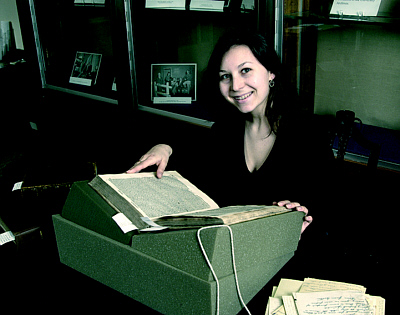
HISTORICAL SHADOW: Ashley Horton
examined the life of Marie-Anne Lavoisier, the little-known
wife of Antoine-Laurent Lavoisier, the father of modern
chemistry.
|
Marie-Anne Lavoisier has gone down in history as her
husband's wife. But senior Ashley Horton believes
Marie-Anne may be important beyond her relation to
Antoine-Laurent Lavoisier, the father of modern chemistry.
Horton, who is majoring in public health studies, used her
PURA to piece together a portrait of Marie-Anne Lavoisier
apart from her husband.
Lawrence Principe, Horton's sponsor and a professor in
the Krieger School's Department of
History of
Science and Technology, said of Lavoisier, "She's not just an
attachment to her husband. She is a fascinating individual
in her own right, and that is what Ashley is trying to
bring out."
Horton has learned that Marie-Anne was not only key to
Antoine-Laurent's work but was also a societal and
political figure in 18th-century France. "I'm interested in
the role she played in Lavoisier's work and to what extent
she was important in his relations with English science,"
said Horton. "He spoke [English] very poorly, and read it
very poorly, so any important treatises she translated into
French."
Marie-Anne Lavoisier also helped smuggle research to
her husband during his imprisonment in Revolutionary France
and, after his execution, led a public and political attack
against the government when it confiscated her property.
But since she has always been a historical shadow,
Horton had to learn archival tricks and search widely for
information, visiting museums and archives from Wilmington,
Del., to Paris. "It's always a problem when you're
searching for someone in the shadows," she said.
Horton, who plans to go into laboratory research when
she graduates, became interested in Marie-Anne Lavoisier
when she took a class called Lives in Science taught by
Daniel Todes.
Her PURA research, she said, has allowed her to move
away from her background in lab research and molecular
biology. "It's given me a more well-rounded education," she
said. "I've taken a lot of chemistry, and it is really nice
to see the humanities side of it."
She also has learned the technological advantages
enjoyed by modern researchers and scientists. "Learning
more about the history of science has given me a real
appreciation of where science is now and the whole
progression of it," she said.
Horton plans eventually to write a short biography
about Marie-Anne Lavoisier. "I think it would be a
bestseller," Principe said.
— Jessica Valdez

STD testing for women
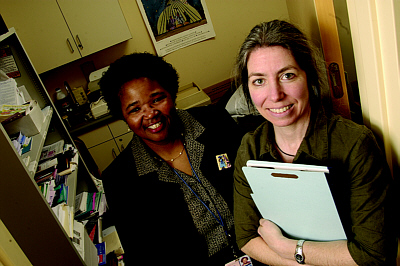
SDT TESTING FOR WOMEN: Megan
O'Brien Gold, right, and sponsor Phyllis Sharps at the Wald
Community Nursing Center at the House of Ruth, site of her
PURA project.
|
Nursing student
Megan O'Brien Gold's project involved
21 women at the House of Ruth, a shelter for female victims
of domestic violence. It is one of several sites that
houses a Wald Community Nursing Center run by School of
Nursing faculty and students. Gold works there as part of
the school's community outreach program.
All women who come to the House of Ruth are seen
initially at the center to familiarize them with its
nursing services, which currently include screening for
sexually transmitted diseases through cervical swab, if a
woman requests it. Knowing that previous research has
linked abusive relationships with increased rates of STDs
among women, Gold explored changing the protocol for
screening for gonorrhea and chlamydia, the most frequently
reported infectious diseases among men and women.
"Women with undiagnosed and untreated infection are at
risk for significant gynecologic problems and increased
risk of HIV transmission," Gold said. "Many of the women we
see at the clinic are not receiving medical attention.
Ideally, every one of them should be offered urine
screening for gonorrhea and chlamydia."
Armed with her PURA, Gold set out to determine two
things: the prevalence of gonorrhea and chlamydia among
women at the shelter, and the acceptability of universal
urine screening. The results of Gold's project were just as
she expected. One woman of the 21 tested positive for
chlamydia, or roughly 5 percent of the study sample,
slightly more than the average of 3 percent for female
Baltimore residents ages 18 to 35. "I wasn't expecting it
to be more, but the results are enough. Now we have the
data we need to validate the implementation of universal
screening," Gold said.
In addition, Gold reports that the women were very
willing and interested in participating and were favorable
to the urine-testing method of screening. "The urine test
is not expensive, and it's noninvasive," she said, noting
that treatment for these diseases is far more costly than
the cost of urine screening.
Gold's faculty sponsor, Phyllis Sharps, is pleased
with the project. "The results of Megan's research have the
potential to change nursing practice in our clinic," said
Sharps, associate professor and director of the school's
master's program. "This could lead to implementing a
quicker, less expensive and accurate method for screening
for STDs and to improving health outcomes for the women who
come to the House of Ruth."
— Ming Tai

Music in 18th-century France
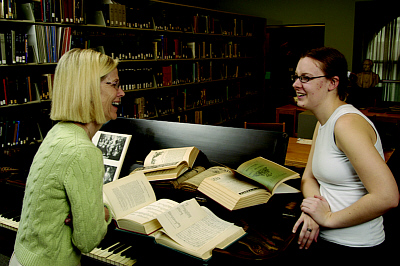
MUSIC IN 18TH-CENTURY FRANCE:
Katherine McDonough, right, worked with sponsor Susan Weiss
on a project that took her to Paris for six weeks of
research.
|
Regulations imposed by the Republican government
during the French Revolution affected many aspects of
France's 18th-century life. The government's attempt to
regulate the music of that period is the focus of research
conducted by sophomore Katherine McDonough, a history and
French major in the
Krieger School. Thanks to her PURA,
McDonough spent six weeks of her summer in Paris in the
music and manuscript divisions of the Bibliotéque
Nationale
de France and the Archives Nationales.
McDonough's attention to French Revolutionary music
began with a chance encounter. While visiting the Oberlin
Conservatory during high school, she had picked up a book
that focused on just this subject. At Johns Hopkins, she
honed her research skills and continued to build her
knowledge of the French Revolutionary period. In the fall
of 2002, she enrolled in a course called From the Court to
the Boulevard: French Theatre and Opera, taught by Nicole
Asquith.
Her final paper in that class focused on an essay
written in 1796 by Jean-Baptiste Leclerc, a member of the
Convention during the Revolution. In his essay, Leclerc, a
lesser-known composer, called for the government to develop
a canon of French national music and to censor the existing
music performance system.
McDonough studied the writings and musical composition
of Leclerc while in France and plans to continue searching
for reviews of his work and evidence that he may have
written more. "Since this project is in the field of
music, my 10 years of classical piano and violin training
will prove extremely useful," she said.
McDonough worked closely on this project with Susan
Weiss, a musicologist at Peabody.
"It is rare to find a student interested in the
history of the impact of political theory on culture, one
gifted enough to be able to read and digest documents in a
foreign tongue, and have the proficiency to understand the
technical language of music theory and composition," Weiss
said. "Katie's work will become a model for others
interested in doing interdisciplinary research."
— Kirsten Lavin

The artistic autistic
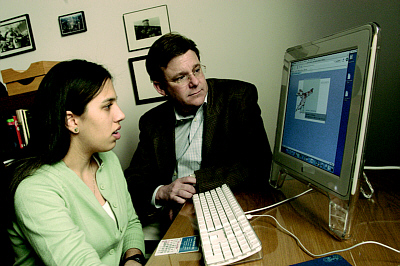
THE ARTISTIC AUTISTIC: Vandna
Jerath and sponsor Tristan Davies look at the Web site
Jerath developed to showcase the creative works of autistic
people.
|
On paper, junior Vandna Jerath's major and minor,
neuroscience and Writing Seminars,
are at opposite ends of
the academic spectrum. But the two disparate disciplines
meet online at the junior's newly created Web site, Autism
Netverse: A Literary Journey for the Autistic Mind,
www.jhu.edu/netverse.
Jerath's PURA project provides an artistic forum for
people with autism who often find it easier to express
themselves through writing and visual arts than through the
spoken word. Visitors will find poetry, sketches, paintings
and photographs by people of all ages.
She was inspired to seek a PURA grant to launch Autism
Netverse after conducting research in summer 2002 near her
hometown of Martinez, Ga., with neuroscientist Manuel
Casanova, then of the Medical College of Georgia, now of
the University of Louisville, where he holds the Gottfried
and Gisela Kolb Endowed Chair in Psychiatry. Her assignment
was to compile an anthology of poetry by highly functioning
autistic individuals.
She found the project rewarding and wanted to take it
further by persuading journals and nonprofit groups to
dedicate sections of their publications to the creative
works of autistic people, but didn't have any luck in the
endeavor. Jerath, who also conducts autism research with
Stewart Mostofsky at the Kennedy Krieger Institute, didn't
want to wait any longer for others to decide her idea had
merit. Thanks to PURA, Jerath was able to strike out on her
own and create Autism Netverse.
"I realized that I didn't need a degree to make an
impact on the autistic community," said Jerath, who intends
to pursue a career in medicine. "The provost grant provided
me with this opportunity. If I hadn't explored the concept
behind the Web site, someone else surely would have in the
future."
On the Remarks page of Autism Netverse, Casanova
explains that Jerath's Web site "encourages those suffering
from autism to write and publish their poetry
electronically. After seeking and failing to find other
media outlets for this art form, she received grant support
to fill this niche herself. Her effort is audacious, akin
to building an airplane while flying it."
Jerath said the project took a little while to get off
the ground. With guidance from her PURA adviser, Tristan
Davies, a senior lecturer in the Writing Seminars, Jerath
was soon in touch with Patricia Kramer and Web designer
Megan Van Wagoner of the university's
Office of Design and
Publications and also had secured a domain name
through the university. Seeking writers and artists,
she sent out
letters to physicians and researchers, and after some
watchful waiting, ultimately received 30 submissions from
as far away as India.
"Vandna is an exceptional person," said Kramer,
director of Design and Publications. "Her passion and
dedication to her endeavor are impressive. Her genuine
enthusiasm is catching, and we caught it. If this is our
next generation, we don't have anything to worry about."
In addition to consultations with Kramer and her staff
and with Davies, Jerath is working with Doug Basford of the
Writing Seminars, who has provided additional insight on
the poetic submissions, she said. "Analyzing the works may
provide clues about the thought process of individuals with
the condition."
Davies said he thinks "the idea can't really lose. It
will be of interest to the general public for the obvious
reasons. There might even be some interesting writing that
gets found there. It's a glimpse into this very confusing
world. Certainly, it's got to be a tool for parents [of an
autistic child] who are struggling with this, by providing
hope that there's something that their child might connect
to. Finally, it shows the perfect union of three things:
the humanities, scientific research and technology. It's a
Web site that might really make a difference."
— Amy Cowles

Earthworms and infiltration
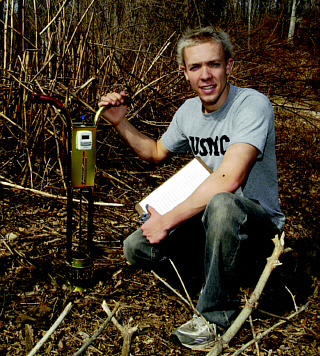
EARTHWORMS AND INFILTRATION: Scott
Pitz spent the summer in the field learning about the
effects of management processes and seasonal changes on
farmland.
|
Scott Pitz used his PURA grant to study earthworms.
Pitz set out last summer to research how different soil
management practices and earthworms affect farmland
infiltration.
"There are different earthworm communities in
different fields," he said. "I wanted to see if the
different earthworm communities would affect
infiltration."
Through fieldwork at the USA-ARS Farming System
Project in Beltsville, Md., he learned that worms and
infiltration are affected by management processes and
seasonal changes.
"We kind of showed again that management affects the
earthworms, and earthworm burrows drastically affect
infiltration," he said. Land use — till or no-till
farming — influences the size and species of
earthworms present in fields, which in turn affects
earthworms' impact on soil and infiltration.
Pitz sampled corn plots in three cropping systems: a
synthetic no-till, a synthetic till and an organic system.
He used two processes to evaluate how well the soil
absorbed water: sprinkle infiltration (which simulates
moderate rainfall) and ponded infiltration (which simulates
heavy rain).
He also evaluated the impact on earthworms.
"Earthworms basically are the most important soil
invertebrates," he said. Their burrowing habits are key to
soil infiltration and can help reduce run-off and pesticide
leakage into surface water sources. But tilling disrupts
earthworm communities by destroying their burrow, he said.
Pitz's effort was part of a larger project conducted
by the U.S. Department of Agriculture, which is looking at
how agricultural practices in the mid-Atlantic can be
sustainable. His project adviser, Katalin Szlavecz, a
senior lecturer in
Earth and Planetary Sciences, is
studying invertebrate communities on these fields.
Pitz had done lab research with Szlavecz, but this was
his first time dealing with the inconsistencies of
fieldwork. "It's not cut and dry; it's not a chem lab where
there's a set number of variables," he said.
Szlavecz said that Pitz's PURA gave him an opportunity
that most undergraduates lack. "I think the students here
don't get a lot of field exposure," Szlavecz said. "Now he
likes fieldwork better than lab work."
— Jessica Valdez

Egyptian dig
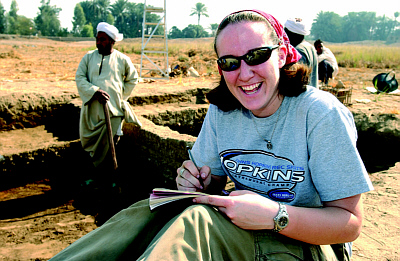
EGYPTIAN DIG: Kathelene Knight
spent winter break working at Professor Betsy Bryan's
excavation of the Precinct of the Goddess Mut in Luxor,
Egypt.
PHOTO BY HPS/JAY
VANRENSSELAER
|
Kathelene Knight's PURA funded her second winter break
at Professor Betsy Bryan's annual excavation of the
Precinct of the Goddess Mut in Luxor, Egypt, where she
contributed to the ongoing work to determine what the
temple and its surrounding area looked like long ago.
Knight said her work in Luxor barely scratched the
surface of all there is to be uncovered at the site. Yet
the two large granaries found within Knight's excavation
trenches south of the temple's sacred lake are important
finds, according to Bryan, the Alexander Badawy Professor
of Egyptian Art and Archaeology and chair of the
Near Eastern Studies
Department.
"These storage facilities are among the largest found
in Egypt," said Bryan, who is Knight's faculty sponsor.
"The two in Katie's squares, one of which was already known
to us but the other not, have been beautifully defined as a
result of Katie's work."
In January 2003, Knight was a second set of hands for
graduate students as they worked their squares, generally
doing anything and everything to pitch in and learn more
about the archaeological techniques used by Bryan and
company. That hands-on experience was invaluable this year
when Knight's role was to direct work in two trenches
— first in a square that had been opened last year
and then in a new square. While taking nonstop notes on her
site's progress, Knight directed a crew of local workers
led by "gufti" Mahmoud Abady who was trained in archaeology
in the Egyptian town of Guft.
"He's known on site as 'Super Gufti,' and I'm sure
there was no mistake in pairing the two of us," Knight
said. "He can spot mud brick from 3 centimeters before it
would come up, and we're talking about spotting dirt inside
dirt."
The two granaries unearthed by Knight and her team
were typically used to make beer and bread for religious
offerings and personnel rations. While the area south of
the sacred lake was industrial and probably partly
residential, the specific area directed by Knight turned
out to be entirely industrial, Bryan said. Because the
mission of the excavation is to investigate the New
Kingdom, Knight was working to define occupation in her
square for that period of time, 1550-1069 B.C. She received
guidance from both Bryan and Violaine Chauvet, a graduate
student and field director at the site.
"Katie did a remarkably fine job overseeing the
excavation," Bryan said. "Katie kept on top of the
architecture emerging and documented her trench extremely
carefully. She participated in developing excavation
strategies to better define the emerging granaries and
retaining walls, and she has created a plan to aid in our
prediction of the volume of grain stored in the round
silos."
Because she is a resident adviser at Homewood, Knight
had to leave Egypt before the end of winter break to return
to Baltimore for additional training. She was unable to
complete all her drawings and was therefore assisted by
Chauvet. Her help was just one example of the close-knit
ties between those working the site, Knight said.
"Dr. Bryan and Violaine were making the rounds
constantly. I could count on them to be in my square a few
times during the day advising me what to do, what I should
be looking out for," Knight said. "It's really a familial
learning experience."
Knight, a junior, is already incorporating her study
of the New Kingdom into a master's thesis through the
Humanities Honors program. She's concentrating on the role
of royal women in the New Kingdom and aims to graduate in
spring 2005 with bachelor's degrees in both anthropology
and Near Eastern studies as well as a B.A./M.A. in the
humanities. Her plan is to complete her thesis during next
year's winter break, so it's unlikely Knight will be back
in Egypt then. But she hopes to attend field school in Peru
this summer with the assistance of a second PURA grant.
"As an undergraduate lucky enough to be at an
institution like Hopkins, I have this wonderful
opportunity, and it's really cool that I can take it," she
said of her PURA experience. "It's an incredible
opportunity that I'm totally thankful for."
— Amy Cowles

Mysterious inner-ear hair cells
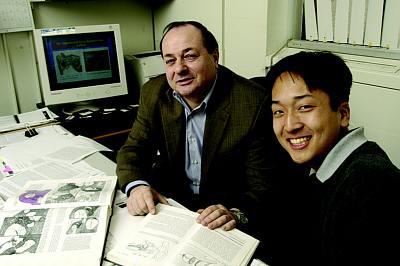
MYSTERIOUS INNER-EAR HAIR CELLS:
William Hsu, right, has been doing research with Alexander
Spector for two years. He hopes to publish his PURA
results.
|
William Hsu, a senior from Westlake Village, Calif.,
is playing an important role in solving the mysteries
surrounding tiny hair cells in the inner ear that help
humans distinguish between high-frequency sounds, an
ability that is critical for understanding speech. The work
could lead to a better understanding of age-related hearing
loss and to the improvement of hearing aids.
Hsu has been working on the research under the
supervision of Alexander Spector, an associate research
professor in the
Department of
Biomedical Engineering,
since his sophomore year. Last fall the BME major used a
PURA to devote more time to the project, with the goal of
publishing results in a peer-reviewed journal.
"William's educational path here was related to his
research," said Spector, his PURA faculty sponsor. "I
encouraged him to take classes relevant to this research.
He's become more and more involved in the project, and now
he has his own piece of it. I plan to submit his work to a
scientific journal by the time of his graduation."
Spector directs a team of students who have been
studying the outer hair cells of the cochlea, a
snail-shaped, fluid-filled structure within the inner ear.
Sound waves vibrate through the cochlear fluid and excite
clusters of hair cells in the surrounding membrane. Inner
hair cells pick up sounds and turn them into electrical
signals that zip across nerve fibers to the brain. Mammals,
including humans, also possess outer hair cells, whose
purpose puzzled researchers for many years because these
cells cannot send sound messages to the brain. In 1985,
however, scientists learned that outer hair cells in the
lab changed their length when subjected to an electric
field. When these hair cells are within the cochlear
membrane, this size-changing characteristic is believed to
give them the ability to amplify certain sounds before the
sounds are transmitted to the brain.
According to Hsu, "these outer hair cells help us
discriminate different frequencies, and that's critical in
understanding human speech. But these hair cells are
delicate. As we age, they can deteriorate and become less
sensitive, leading to hearing loss."
To address this problem, researchers need a better
understanding of how outer hair cells do their work.
Spector's team has been trying to solve some of the
mysteries surrounding why the electrical activity of these
cells seems to behave differently in the lab than within
living tissue. As part of this project, Spector assigned
Hsu to create mathematical models of the ionic channels in
the outer hair cell membrane. These microscopic gatekeepers
allow ions to move in or out of cells, changing the cell's
overall electric potential. By varying the parameters of
the computer model, Hsu is trying to find the combination
that will resolve the cell's electrical activity
paradox.
"Working with Dr. Spector has given me a different
perspective on research," Hsu said. "When I came to
Hopkins, I thought research involved sitting behind a lab
bench, working with chemicals. I didn't know that research
could involve creating computer models. I've learned that
we can do experiments with them. We can play around with
our models and see how well they predict what happens in
the actual cells."
— Phil Sneiderman

Researching international justice
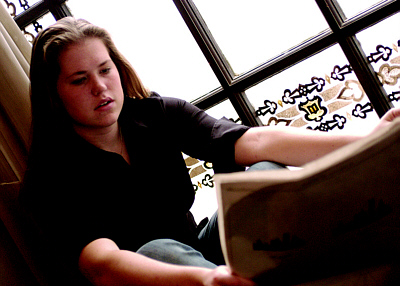
RESEARCHING INTERNATIONAL JUSTICE:
Amanda Leese headed to The Hague, Netherlands, to observe
trials in the International Criminal Tribunal.
|
Amanda Leese, a sophomore, spent three weeks last
summer in The Hague, Netherlands, researching international
justice by observing and interviewing those involved in
trials in the International Criminal Tribunal.
The international relations major was there to observe
the trial of Slobodan Milosevic, the former president of
Yugoslavia, who is defending himself on charges of
committing war crimes and other atrocities. At the
International Criminal Tribunal for Yugoslavia, Leese was
among each day's spectators watching through thick
bulletproof glass while listening to testimony on
headphones. Each member of the public was given a
translating device, which could be set on the language of
his or her choice, she said. Without the headphones,
nothing could be heard through the thick glass, giving her
a detached feeling, she said.
She was surprised, she said, that more people didn't
observe the trial, which is still going on; with room for
about 80 spectators, Leese said, there were usually just 15
to 20 people, not counting the press.
Although the most sensitive testimony was closed to
the public, Leese heard hours of testimony from people
describing firsthand the atrocities they had seen or
endured, an experience she likened to "listening to Anne
Frank read from her diary."
Leese, whose faculty sponsor was Siba Grovogui, is
hoping to return to The Hague this summer to learn
more.
— Glenn Small

Healthy heartbeat
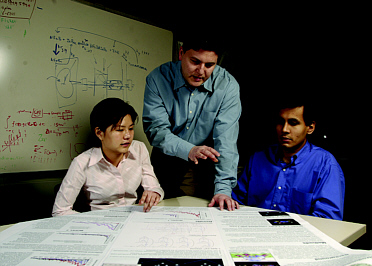
HEALTHY HEARTBEAT: Bhuvan
Srinivasan, right, with his PURA faculty sponsor, Andre
Levchenko, and Carol Xiaoying Koh, who also works on the
research team.
|
Bhuvan Srinivasan and Carol Xiaoying Koh are mapping
the interaction of molecules within a cardiac cell,
describing microscopic movements that could be critical for
maintaining a healthy heartbeat. The two undergraduates,
both biomedical engineering majors, have presented their
findings at prestigious computational biology conferences
and are now collaborating with their faculty supervisor on
a paper for a scientific journal.
Working in the lab of Andre Levchenko, an assistant
professor in
Biomedical Engineering, the two have been
tracking within a detailed computer model the activity of
molecules in a small region inside cardiac myocytes, the
muscle cells that mediate contractions of the heart.
"The contraction of the myocytes is controlled by tiny
sub-sections of the cell with a volume so small that you
could count some of the molecules present there on one
hand," Levchenko said. "But by modeling the interaction
between single molecules in these areas, we think we can
predict what's going to happen to the entire heart. What
happens here sets off a chain reaction of events leading to
heart contraction."
Levchenko is impressed by what the two undergraduates
accomplished in assembling part of this model. "The level
of work done by Bhuvan and Carol is close to that of very
good graduate students," Levchenko said. "I've given them a
little advice, but they've mostly run with it by
themselves. They're exceptional students. I've sometimes
come into the lab at 3 a.m. and found them working on the
project."
Srinivasan has been working in Levchen-ko's lab for
two years and used a PURA to devote additional time to the
project last summer. Koh, who has been working in the lab
for more than a year, is supported by a scholarship from
the government of Singapore. The two students attended the
same high school in Singapore but were not acquainted
before they arrived at Johns Hopkins.
Over the past year, they worked on separate aspects of
the research, then put their findings together. Koh has
defined and spearheaded the project by gathering various
information from the literature and coding it into the
modeling software. Srinivasan assembled a computer model of
the protein kinase A pathway, a communication route along
which signals move between the outside and inside of the
cell. The model can now describe molecular events arising
from both signaling and cell contraction regulation. "Now
we can ask, What if something happens to this pathway?"
Levchenko said. "How would it affect the interaction of
molecules within the cells, and how would this affect the
contractions of the heart as a whole?"
In the fall, Srinivasan presented some of the team's
work at the NIH Digital Biology Conference in Bethesda,
Md., where the poster was singled out as a highlight of the
meeting. Koh traveled to Washington University in St. Louis
to present the research at the International Conference on
Systems Biology, the premier event in the emerging
scientific field. Both were surprised to discover that they
were the rare undergraduate presenters, fielding questions
from prominent full-time researchers, including some whose
work they had studied.
Although Srinivasan is not scheduled to receive his
bachelor's degree until May, he already has begun working
toward his master's degree in biomedical engineering at
Johns Hopkins. "It was definitely a big deal for me to come
to America's first research university," said Srinivasan, a
citizen of India whose family relocated to Singapore when
he was in sixth grade. "It's been very easy to get involved
in research here and to do something worthwhile — not
just cleaning lab equipment. I liked working with Dr.
Levchenko, and I wanted to stay as long as I could."
— Phil Sneiderman

A new microchip
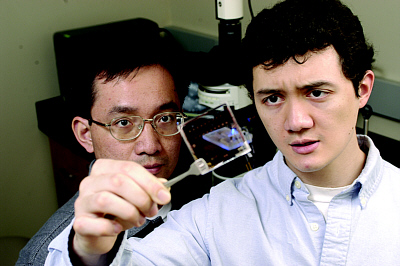
A NEW MICROCHIP: Eric Simone,
right, holds up the microchip he constructed under the
supervision of Jeff Tza-Huei Wang. It has an innovative
circular electrode design.
|
Eric Simone, a senior
biomedical engineering major,
has constructed a new type of microchip that can move and
isolate DNA and protein molecules. He believes that by
linking the chip with analysis equipment, a user could
identify medical ailments, monitor a patient's health or
detect viruses and other biohazards before they spread.
Simone fabricated and tested the chip in the lab of
Jeff Tza-Huei Wang, an assistant professor in the
Department of Mechanical Engineering. Wang had already
produced a biosensor chip with electrodes embedded in a
straight line. Under Wang's supervision, Simone devised a
biosensor chip with an innovative circular electrode
design, which performed more effectively in certain
bio-analytical applications.
Results from Simone's work were included in a paper
presented recently at the IEEE MEMS Conference. The
undergraduate was listed as second author on the paper.
"This chip gives us a new tool to look into biological
questions," said Wang, who also is a faculty member of the
Whitaker Biomedical Engineering Institute at Hopkins. "Eric
can actually interact with and manipulate individual DNA
molecules."
Simone joined Wang's lab team in January 2003 and used
a PURA to spend much of last summer working on his project.
"The chip has tiny wires, each about one-fifth the diameter
of a human hair, embedded in a circular pattern," Simone
said. "When it's connected to a power source, it allows us
to generate an electric field that can transport molecules
to a designated area for study."
The chips made by Wang and Simone take advantage of
the natural negative charge possessed by DNA or a surface
charge imposed on the molecules. A tiny drop of liquid
containing the DNA is placed atop the chip. The electric
field then guides the molecules to the designated area,
where they can be analyzed under a microscope.
Simone was one of the first students to work in Wang's
new lab, which focuses on microelectromechanical systems
with biological applications. "It was fascinating," Simone
said. "It was like discovering a whole new field of
science."
After graduating, Simone hopes to continue his
education in a biomedical engineering doctoral program.
— Phil Sneiderman

The 11th Annual PURA Ceremony: Check Out Their
Results
To recognize the recipients of the 2003 Provost's
Undergraduate Research Awards, an event will be held from 3
to 6 p.m. on Thursday in Homewood's Glass Pavilion.
A poster session in which students will have an
opportunity to display the results of their research begins
at 3 p.m. At 4:15 p.m., recipient Katharine McDonough and
others will perform a piece by Jean Baptiste Leclerc, a
writer/politician/composer during the French Revolution and
the focus of McDonough's project.
At the 4:30 p.m. recognition ceremony hosted by Steven
Knapp, provost and senior vice president for academic
affairs, Knapp will introduce the honorees, and Theodore
Poehler, vice provost for research and chair of the
selection committee, will present the students'
certificates. Also on the agenda is a preview of Daniel
Davis' historically based opera, which will premiere at
Peabody.
The entire Johns Hopkins community is invited.

SUMMER 2002 PROJECTS
Trevor Adler, Sands Point, N.Y.
senior, history
"Historical Research of the Methods and Motivations for
Raising Ships"
Sponsor: John Russell-Wood, professor, History,
Krieger School of Arts and
Sciences
Oluwakemi Ajide, Baltimore
sophomore, chemistry
"Dynamics of the Fusion Pore During Cell-Cell Fusion"
Sponsor: Eric Grote, assistant professor,
Biochemistry and Molecular Biology, School of Public
Health
Tala Altalib, Baltimore
junior, undeclared
"Modulation of TNF-Alpha Expression in Human Chondrocytes
and
Synoviocytes by NSAIDs and Ginger Extract"
Sponsor: Carmelita Frondoza, associate professor,
Orthopedic Surgery, School of Medicine
Heather Blair, Norfolk, Mass.
senior, public health studies
"Mapping the Prevalence of HIV Against That of Tuberculosis
in
Johannesburg, South Africa"
Sponsor: James Goodyear, associate director, History
of Science and Technology, Krieger School of Arts and
Sciences
Megan O'Brien Gold, Baltimore
senior, nursing
"Universal Urine Screening for Neisseria Gonorrhoeae and
Chlamydia Trachomatis Among Battered Women"
Sponsor: Phyllis Sharps, associate professor and
director of the master's program, School of Nursing
Ashley Horton, Spokane, Wash.
senior, public health studies
"Marie-Anne Lavoisier: A Woman of Scientific and Cultural
Importance"
Sponsor: Lawrence Principe, professor, History of
Science and Technology, Krieger School of Arts and
Sciences
Brett Kutscher, Reading, Pa.
senior, computer enginering
"Fluorescence Recovery After Photobleaching
Instrumentation"
Sponsors: Doug Murphy, professor, Cell Biology, School of
Medicine, and Pablo Iglesias, professor, Electrical and
Computer Engineering, Whiting School of Engineering
George Lambrinos, Athens, Greece
junior, neuroscience
"The Role of Wallerian Degeneration in the Pathogenesis of
Neuropathic Pain Following Peripheral Injury"
Sponsor: James Campbell, professor, Neurosurgery,
School of Medicine
Adrea Lee, Andover, Mass.
senior, biology
"The Role of Fractalkine in the Pathogenis of HIV
Dementia"
Sponsor: Carlos Pardo-Villamizar, assistant
professor, Neurology, School of Medicine
Johnson Lee, Arcadia, Calif.
senior, biology
"Smooth Muscle Differentiation of Human Embryonic Stem
Cells (hESCs)"
Sponsor: Yegappan Lakshmanan, assistant professor,
Urology, School of Medicine
Amanda Leese, Amherst, N.H.
semior, international studies
"Human Rights Violators and the International Court of
Justice: Contrasting the Barbarity of Crimes with the
Dignity of Laws"
Sponsor: Siba Grovogui, associate professor,
Political Science, Krieger School of Arts and Sciences
Daniel Loeser, Baldwin, N.Y.
senior, biomedical engineering
"A Miniaturized Contact Fluorescence Imaging System
Incorporating True Contact and Solid-State
Illumination"
Sponsor: Leslie Tung, associate professor,
Biomedical Engineering, School of Medicine
Holly Martin, Houghton, Mich.
senior, international relations and German
"We Are What We Eat: U.S. Consumption Trends vs.
Sustainable Protein Sources"
Sponsors: Felicity Northcott, lecturer, and Sidney Mintz,
professor emeritus,
Anthropology, Krieger School of Arts and Sciences
Katherine McDonough, Roswell, Ga.
sophomore, history and French
"French Musicians and the Political World of the 1789
Revolution"
Sponsor: Susan Weiss, faculty, Peabody Institute
Paul Nerenberg, Los Angeles
senior, physics
"STILLMix — Surface Tension Impelled Low-Gravity
Liquid Mixing Experiment"
Sponsor: Cila Herman, professor, Mechanical
Engineering, Whiting School of Engineering
Allan Olson, Brattleboro, Vt.
sophomore, civil engineering
"Network Modeling of Polycrystals"
Sponsor: Sanjay Arwade, assistant professor, Civil
Engineering, Whiting School of Engineering
Jin Packard, Baltimore
senior, public health studies
"Mechanism of Vesicular Formation in Yeast Endocytosis"
Sponsor: Beverly Wendland, assistant professor,
Biology, Krieger School of Arts and
Sciences
Scott Pitz, Paoli, Pa.
senior, earth and planetary sciences
"How Do Earthworm Communities Affect the Hydrology of
Agro-Ecosystems?"
Sponsor: Katalin Szlavecz, senior lecturer, Earth
and Planetary Sciences, Krieger School of Arts and
Sciences
Eric Simone, Anderson Township, Ohio
senior, biomedical engineering
"Fabrication of Micro DNA Biosensor Chip with Embedded
Concentration Electrodes"
Sponsor: Jeff Tza-Huei Wang, assistant professor,
Mechanical Engineering, Whiting School of Engineering
Bhuvan Srinivasan, Singapore
senior, biomedical engineering
"Comparison of Deterministic and Stochastic Models of the
PKA Pathway"
Sponsor: Andre Levchenko, assistant professor,
Biomedical Engineering, Whiting School of Engineering
Ankit Tejani, Kingston, Pa.
senior, biomedical engineering
"Use of Erythropoietin as a Novel Treatment in a Murine
Model of Myocardial Infarctions"
Sponsor: Joshua Hare, associate professor,
Biomedical Engineering, Whiting School of Engineering
Denise Terry, Fort Irwin, Calif.
junior, political science
"LIFE: A Photo Essay"
Sponsor: Deborah McGee Mifflin, lecturer, German,
Krieger School of Arts and Sciences
Rebbeca Tesfai, Southfield, Mich.
senior, public health
"The Achievement of Immigrant Populations in Urban High
Schools"
Sponsor: Stephen Plank, assistant professor,
Sociology, Krieger School of Arts and Sciences
Anand Veeravagu, Grapevine, Texas
junior, biomedical engineering
"A Model for the Quantification and Analysis of Long-Range
Spinal Cord Regeneration"
Sponsor: Lawrence Schramm, professor, Biomedical
Engineering, School of Medicine
Simon Zaleski, Ellicott City, Md.
sophomore, piano performance
"Infusing New Beauty into Modern Music Using Ideas From the
Past"
Sponsor: Webb Wiggins, faculty, Peabody Institute

FALL 2002 PROJECTS
Veronica Beaudry, Manchester, N.H.
senior, biology
"F1G1p: A Key Regulator of LACS (Low-Affinity Calcium
Influx System) in Yeast"
Sponsor: Kyle W. Cunningham, associate professor,
Biology, Krieger School of Arts and Sciences
Jeff Chang, San Jose, Calif.
senior, neuroscience
"The Role of IP3 Receptors in Visual Cortical Long-Term
Depression"
Sponsor: Alfred Kirkwood, assistant
professor, Neuroscience, School of
Medicine
Raghu Chivukula, Wichita, Kan.
junior, neuroscience
"Neuroprotective Mechanisms in a Mouse Model of Amyotrophic
Lateral Sclerosis (ALS)"
Sponsor: Katrin I. Andreasson, assistant professor,
Neurology, School of Medicine
David Choi, Fairfax, Va.
senior, psychology
"Stiffness Analysis of an External Fixator System Using
Graphic Modeling and Numerical Simulations"
Sponsor: Edmund Y.S. Chao, professor, Orthopedic
Surgery, School of Medicine
Daniel Davis, Waxhaw, N.C.
senior/master's degree, history; senior, music
composition
"If I Were a Voice, A Historically Based Opera on the
Hutchinson Family"
Sponsor: Michael P. Johnson, professor,
History, Krieger School of Arts and Sciences
Inga Gurevich, Fort Lee, N.J.
senior, neuroscience
"Optimal Parameters for Intrastriatal Transplantation in
Parkinson's Disease"
Sponsor: Anirvan Ghosh, former professor,
Neuroscience, School of Medicine
William Hsu, Westlake Village, Calif.
senior, biomedical engineering
"Modeling High Frequency Membrane Potentials in Cochlear
Outer Hair Cells: Providing Insight Into Active
Hearing"
Sponsor: Alexander Spector, associate
research professor, Biomedical Engineering, Whiting School
of Engineering
Vandna Jerath, Martinez, Ga.
junior, neuroscience
"Autism Netverse: A Literary Journey for the Autistic
Mind"
Sponsor: Tristan Davies, senior
 GO TO MARCH 8, 2004
TABLE OF CONTENTS.
GO TO MARCH 8, 2004
TABLE OF CONTENTS.
 GO TO THE GAZETTE
FRONT PAGE.
GO TO THE GAZETTE
FRONT PAGE.
|